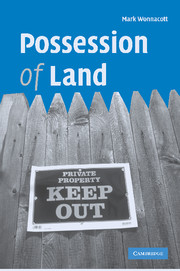Book contents
- Frontmatter
- Contents
- Preface and acknowledgments
- Table of cases
- Table of statutes
- Table of statutory instruments
- 1 Meaning of possession
- 2 Protection of possession
- 3 Possession, title and freehold land
- 4 Leases and licences
- 5 Mortgages and charges
- 6 Equity and trusts
- 7 Birth and death, dissolution and insolvency
- 8 Adverse possession and prescription
- 9 Possession judgments
- 10 Summary and conclusions
- Index
10 - Summary and conclusions
Published online by Cambridge University Press: 13 August 2009
- Frontmatter
- Contents
- Preface and acknowledgments
- Table of cases
- Table of statutes
- Table of statutory instruments
- 1 Meaning of possession
- 2 Protection of possession
- 3 Possession, title and freehold land
- 4 Leases and licences
- 5 Mortgages and charges
- 6 Equity and trusts
- 7 Birth and death, dissolution and insolvency
- 8 Adverse possession and prescription
- 9 Possession judgments
- 10 Summary and conclusions
- Index
Summary
Meaning of possession
The word ‘possession’ is used, in English land law, to describe three different, related but inconsistent concepts. That is why it is so confusing.
It is primarily used to describe a relationship between a person and a legal estate in land: a fee simple, or a lease, or (notwithstanding that it is technically an ‘interest’ rather than an ‘estate’) a profit à prendre.
A person has a right to possess that estate if he or she has acquired a title to it which carries with it a fixed right to enjoy it now; that is, a title to it which is ‘vested in possession’.
A person is ‘in’ possession of that estate if he or she (and not someone else) is, as a matter of observable fact, substantially enjoying the benefit of it; that is, taking the benefit of the estate, rather than the physical land itself.
But ‘possession’ is also sometimes used as a synonym for ‘occupation’. A person is in occupation of land when physically present upon it, or when otherwise making some tangible use of it.
More rarely, nowadays, ‘possession’ is also used in a third, wholly fictional, sense, called ‘constructive’ possession. The law sometimes deems a person to be, or to have been, in possession of an estate in land, when, in fact, that is not, or was not, the case.
- Type
- Chapter
- Information
- Possession of Land , pp. 161 - 169Publisher: Cambridge University PressPrint publication year: 2006



